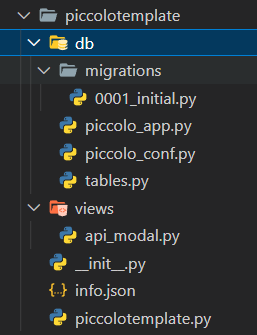Piccolo Postgres integration for Red
Project description
red-postgres
Piccolo Postgres integration for Red-DiscordBot, although it could be used with any dpy bot as an easy wrapper for making postgres with cogs more modular.


Install
pip install red-postgres
File structure for using with cogs
cog-folder/
├── db/
│ ├── migrations/
│ ├── piccolo_conf.py
│ ├── piccolo_app.py
│ ├── tables.py
├── __init__.py
├── cog.py
Cog Usage
import asyncio
from pathlib import Path
from piccolo.engine.postgres import PostgresEngine
from redbot.core import commands
from redbot.core.bot import Red
from red_postgres import register_cog
from .db.tables import MyTable
class PiccoloTemplate(commands.Cog):
def __init__(self, bot: Red, *args, **kwargs):
super().__init__(*args, **kwargs)
self.bot = bot
self.db: PostgresEngine = None
async def cog_load(self):
asyncio.create_task(self.setup())
async def setup(self):
await self.bot.wait_until_red_ready()
config = await self.bot.get_shared_api_tokens("postgres")
self.db = await register_cog(self, config, [MyTable])
async def cog_unload(self):
if self.db:
self.db.pool.terminate()
The config for piccolo should have the following keys:
{
"database": "postgres", # Replace with your maintenance database
"host": "127.0.0.1", # Replace with your host
"port": "5432", # Replace with your port
"user": "postgres", # Replace with your user
"password": "postgres" # Replace with your password
}
Note: database name in your config should normally be the default "postgres", this library will automatically handle connecting your cogs to their own database
The register method connects to the database specified in config, creates the a new database with the name of the registering cog, registers any tables, runs any migrations, sets the new engine object to all tables, and returns the raw engine object.
- The name of the database will be the the name of the cog's folder, not the name of the main cog.py file
You can then use your piccolo table methods like so:
count = await MyTable.count()
or
objects = await MyTable.objects().where(MyTable.text == "Hello World")
The engine associated with your tables after registering the cog is connected to the database named the same as the cog that registered them, thus using this integration with multiple cogs will not interfere, as each cog will create its own database.
- If your cog's folder name is
MyCogthen the database will be namedmycog
Piccolo Configuration Files
Your piccolo configuration files must be setup like so. This is really only used for migrations.
- When migrations are run, the os environment variables are mocked in subprocess, so there should be no conflicts
piccolo_conf.py
import os
from piccolo.conf.apps import AppRegistry
from piccolo.engine.postgres import PostgresEngine
DB = PostgresEngine(
config={
"database": os.environ.get("POSTGRES_DATABASE"),
"user": os.environ.get("POSTGRES_USER"),
"password": os.environ.get("POSTGRES_PASSWORD"),
"host": os.environ.get("POSTGRES_HOST"),
"port": os.environ.get("POSTGRES_PORT"),
}
)
APP_REGISTRY = AppRegistry(apps=["db.piccolo_app"])
piccolo_app.py
import os
from piccolo.conf.apps import AppConfig, table_finder
CURRENT_DIRECTORY = os.path.dirname(os.path.abspath(__file__))
APP_CONFIG = AppConfig(
app_name="cogname", # Replace with your cog name
table_classes=table_finder(["db.tables"]),
migrations_folder_path=os.path.join(CURRENT_DIRECTORY, "migrations"),
)
for table_classes add in the list of tables you're using
Local development and making migrations
Handing migrations is up to you, but one way to do it is to make migrations locally like so:
First make an .env file in the root of your cog's folder.
POSTGRES_HOST=localhost
POSTGRES_PORT=5432
POSTGRES_USER=postgres
POSTGRES_PASSWORD=postgres
POSTGRES_DATABASE=postgres
Then create a build.py file in your cog folder.
import asyncio
import os
from pathlib import Path
from dotenv import load_dotenv
from engine import engine
load_dotenv()
config = {
"user": os.environ.get("POSTGRES_USER"),
"password": os.environ.get("POSTGRES_PASSWORD"),
"database": os.environ.get("POSTGRES_DATABASE"),
"host": os.environ.get("POSTGRES_HOST"),
"port": os.environ.get("POSTGRES_PORT"),
}
root = Path(__file__).parent
async def main():
created = await engine.ensure_database_exists(root, config)
print(f"Database created: {created}")
description = input("Enter a description for the migration: ")
print(await engine.create_migrations(root, config, True, description.replace('"', "")))
print(await engine.run_migrations(root, config, True))
if __name__ == "__main__":
asyncio.run(main())
You would have a similar file in the root of each of your cog folders, here you would create the migrations to include in your cog folder for users to run when they load up the cog.
Project details
Release history Release notifications | RSS feed
Download files
Download the file for your platform. If you're not sure which to choose, learn more about installing packages.
Source Distribution
File details
Details for the file red-postgres-0.5.0.tar.gz.
File metadata
- Download URL: red-postgres-0.5.0.tar.gz
- Upload date:
- Size: 9.0 kB
- Tags: Source
- Uploaded using Trusted Publishing? No
- Uploaded via: twine/5.1.1 CPython/3.11.2
File hashes
| Algorithm | Hash digest | |
|---|---|---|
| SHA256 | 6f736af5a82068e428e14986712fa607df1d41291e1b52293fb2f8f7ae0017e6 |
|
| MD5 | 7a0dcb4dfdd5a3e64e1d800872976625 |
|
| BLAKE2b-256 | b842012c05b91004893df4a0e577ba250133352293046a266d56132fe5fd68f7 |
















